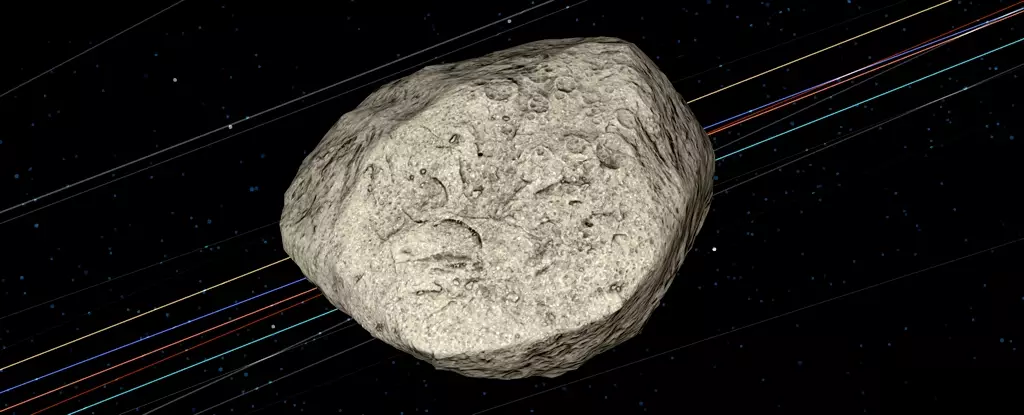In 2029, the world’s gaze will be fixed on a celestial visitor: asteroid 99942 Apophis. Named after the ancient Egyptian god of chaos, this rock made headlines back in 2004 when initial calculations hinted at the frightening possibility of a collision with Earth. While extensive reassessments have since cleared the asteroid of any imminent threat, its upcoming close approach ignites a fascinating dialogue about the relationship between Earth and near-Earth objects (NEOs) and has critical implications for our understanding of asteroids and their evolutionary paths.
Upon its discovery, 99942 Apophis instilled fear due to predictions of a possible impact in 2029. However, as scientists have refined their models and observational techniques, they now confidently assert that the asteroid will pass within 32,000 kilometers (approximately 20,000 miles) of Earth’s surface— a distance that, while close in cosmic terms, poses no danger for the foreseeable future. Yet, this near encounter provides an invaluable opportunity to study Apophis and gain insights into the nature of asteroids that share proximity with our planet.
Asteroids, including Apophis, are remnants from the early solar system. They carry clues about the conditions that existed during the formation of planets around 4.5 billion years ago. While studying these ancient bodies can uncover secrets about the genesis of our solar system, the proximity of such NEOs raises questions about how interactions with Earth might reshape them.
A pivotal aspect of the upcoming flyby revolves around gravitational interactions. The work spearheaded by planetary scientist Ronald Ballouz and his team posits that such encounters can significantly affect the surface characteristics and rotational dynamics of asteroids. 99942 Apophis may have an unusual surface, described as “loose” and “rubbly,” deviating from the more consolidated appearance of asteroids not subjected to close planetary encounters. It sparks curiosity among researchers about how such flybys could rejuvenate or erode the surfaces of asteroids like Apophis, leading to phenomena we have not fully understood.
Furthermore, Ballouz and his colleagues have conducted modeling based on the expected 2029 flyby. They speculated that as Apophis draws closer to Earth, it may experience seismic activity similar to an earthquake, possibly manifesting as a series of short-term disturbances. Such phenomena may be detected by terrestrial instruments, providing a rare real-time examination of changes occurring in the asteroid as it interacts gravitationally with Earth. These vibrations could result from the repositioning of loose materials on the asteroid’s surface, revealing a vivid picture of its physical state.
Long-Term Implications on Asteroid Characteristics
But this interaction may not only rattle the asteroids in the short term; Ballouz’s team suggests that the effects of Earth’s gravity could lead to longer-term alterations, including changes in rotation. Asteroids typically maintain their spin states for extended periods; however, a close encounter with a larger body could introduce new dynamics, creating a fresh surface over thousands of years. This renewal hints at a form of “space weathering,” suggesting that the older age of an asteroid does not definitively equate to an unchanged surface.
Historically, most models for asteroid evolution do not account for the extent of alteration induced by nearby planetary bodies. With Apophis set to pass significantly within the predicted maximum distance for meaningful change, scientists are excited about embracing advanced observational methodologies, potentially refining our understanding of asteroid evolution across the solar system.
The advancements in technology and the focus on asteroids like Apophis highlight a paradigm shift in how we approach these space rocks. Rather than mere curiosities, near-Earth asteroids are becoming focal points for scientific collaboration, potential resource utilization, and interdisciplinary studies concerning planetary protection.
As 99942 Apophis becomes visible to the naked eye during its close approach in 2029, it offers an unprecedented chance for both observational astronomy and public engagement. The scientific community is poised to gather data that could facilitate further research on not just the asteroid itself, but on the broader implications such objects have on celestial mechanics, planetary geology, and our very understanding of Earth’s place in the cosmos.
To conclude, the impending close encounter with asteroid 99942 Apophis is more than just a celestial spectacle; it is an invitation to broaden our knowledge of the universe. By studying these transient visitors, we can uncover secrets hidden for millennia and refine our models of the dynamic and interconnected world of asteroids, planets, and their gravitational relationships. As we prepare for this event, one thing is certain: the sky is not the limit; it’s just the beginning.


Leave a Reply